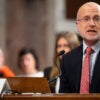The accounting methodology used to measure the cost to taxpayers of federal loan guarantee programs such as the one that financed defunct solar company Solyndra may dramatically understate the programs’ financial risk to taxpayers. Simply put, the federal government ignores administrative costs and the risks of borrowers defaulting on their obligations.
Under the Federal Credit Reform Act of 1990, the cost of federal financing is measured according to a discounted rate based on the cost of lending Treasury securities. That includes the cost of average losses from loan defaults, but it does not take market risk into account – the risk that borrowers will default based on present market conditions – or the administrative costs associated with it.
In other words, the costs of federal loan guarantees are completely divorced from the financial realities facing private lenders. That reduces the cost of the programs on paper, but during periods of financial turbulence and a weak economy, the cost of the programs can be far higher than the FCRA methodology predicts.
Fair-value accounting, an alternative method of measuring the costs to taxpayers of federal programs, does take the state of financial markets into account when estimating the costs of various financing mechanisms. Hence, it tends to produce a more accurate picture of the financial risks borne by taxpayers.
Because fair-value accounting “include[s] administrative costs and the cost of risk,” explained Congressional Budget Office director Doug Elmendorf in March, “fair-value estimates provide a more comprehensive measure of the cost of loan and loan guarantee programs.”
Elmendorf explained the difference in a letter to Sen. Judd Gregg, who asked for CBO to score President Obama’s government takeover of the student loan industry. CBO discovered that the FCRA measure understated the cost of the proposal by $28 billion.
All CBO scores are based on the FCRA methodology unless the lawmakers who request them specify otherwise. That inevitably leads to inaccurate scoring, since market conditions are constantly changing. And of course failing to account for administrative costs further understates the true price tag of a subsidy or loan guarantee.
Recognizing that fact, House Budget Committee Chairman Paul Ryan is looking for a fair-value accounting of the costs of the Energy Department loan guarantee program that financed Solyndra. Ryan wrote a letter to Herb Allison, who is conducting the administration’s review of the program, raising concerns about potential inaccuracies in existing cost estimates.
“Including an adjustment for market risk,” Ryan wrote, “would show the full subsidy cost of DOE’s loan guarantees and permit a better assessment of the costs of subsidizing these private sector activities.”
Ryan also hinted that the Budget Committee may look to reform federal accounting procedures to more accurately assess the costs of federal financing programs.

































3 Replies to “Federal Accounting May Understate Costs of Solyndra-style Programs”